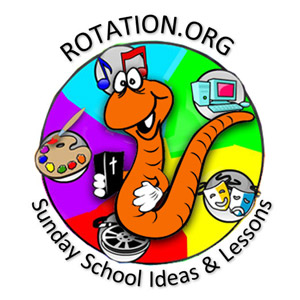This brief article has been compiled by Wormy from previous discussions and advice given at this site.
WoRM in a LARGE Sunday School
One of the attractions of the Workshop Rotation Model (aka The WoRM), is its proven scalability. With some creative scheduling and adjustments, Rotation can work pretty much the same way in churches with 15 kids and churches with 150 kids.
Rotation is being done in very small churches with fewer than 50 members, and in churches with 3000 and 6000 members. There are "mega" churches that use the WoRM too.
From this point forward, the term "large" refers to the # of children, and not the size of the congregation (for as we know, some large congregations have small numbers of children).
Of course, large churches, like small churches, can have certain peculiarities and opportunities that require or allow them to customize their approach. That's to be expected. The adaptability of the WoRM is one of the things that creative leaders enjoy.
It's important to recognize that the concept of "workshop" and "rotation" mostly describe how the individual child best learns: through various media, and by repeating the story for several weeks in a row. Regardless of size, your teachers are still individuals who will do better in a workshop that matches their skills, and get to repeat their lesson each week for a new group. You don't change these fundamental concepts based on size, rather, you simply do some creative scheduling to accommodate these Rotation principles.
**Sometimes in very small churches, you may only use a workshop once during the rotation because you may only have one class! In those cases, you still don't want the same teacher trying to teach each workshop. See our article about the WoRM in Small Churches.
Another Rotation principle which isn't affected by size is the number of weeks you will spend on any one story. Whether you have 10 or 400 kids, each student needs an average of 4 to 5 weeks per story to really let it sink in, and learn it through a variety of media.
Scheduling Workshops in a Large Program
If you have five grades, each with 15 or fewer students, and five workshop rooms available, then scheduling is easy! But in a large church with 40 fourth graders, it gets a little more complicated.
Depending on available room sizes, many large churches with 30+ kids per grade will SPLIT that group in two. Why? 15 kids is psychologically and logistically easier on the volunteers than 30, and many curriculum activities (such as games and discussion) are designed for or work better with smaller groups than larger. This is somewhat dependent on the size of your classrooms and which workshops the kids are rotating into.
The variables: available room size, class size, and the type of learning activity.
Certain types of learning activities need room to move about, and certain types of learning activities are particularly sensitive to "too many kids."
For example...
You may have a Video Workshop or Music Workshop that can handle all 30 of your fourth graders. But you may have an Art Workshop space that is big enough, but doing computers or games with 30 kids in a space that's too small can be frustrating. Cooking Workshops feel that pressure too. 30 kids can generate a lot of oven time and clean up. Thus, some large Rotation Sunday Schools will SPLIT their BIG grades in two for certain workshops, and keep them together for others.
Another variable is the STYLE of activity and the lesson plans themselves. Some lesson plans seem written for smaller groups, and others work okay in small or large groups. So how GOOD are YOU at adapting lesson plans and ideas?
It's easy to adapt a video workshop lesson plan, but more challenging to ADAPT or reconfigure a GAME for a large group.
Needless to say, if you are sometimes combining, and sometimes splitting grades, you need to have a highly visible schedule and good signage.
Many large churches with large class sizes solve their scheduling needs by creating TWO OF THE SAME WORKSHOPS.
They may have 2 Art Workshops, 2 Game Workshops, 2 Cooking Workshops, 2 Computer Workshops, 2 Drama Workshops ---each with 15 to 20 students. This allows your students and teachers to experience a more intimate learning experience. (If you have fewer than 15 to 18 kids in a grade, stick with 1 workshop !)
Where it can get a bit complicated is when you have an IMBALANCE of ATTENDANCE between certain grades. Say for example, you have 40 fourth graders, but only 20 third graders. It can happen. In that case, you might split your fourth graders into two Art Workshops the same Sunday, but only use one of your Art Workshop spaces for your third graders.
Available Room Size is a Big Factor in your Workshop design and schedule.
Creating a super-big Art Workshop for 40 children each week can be chaotic if your space and organization isn't great. But some large churches can pull it off because they have a high level of organization, a great lead teacher, good number of volunteers, and a good-sized room.
In many churches, however, room sizes vary from room to room. So you will want to carefully assess when and where to split your kids or place your workshops.
Rather than create duplicate workshops, some large Rotation Sunday Schools create a DIFFERENT WORKSHOP per group.
For example....
If you have 8 different rotating groups of 15 kids each, you would create 8 different workshops for them to rotate through per story. Importantly, however, you would likely KEEP to a 5 week rotation story schedule. You would not necessarily create an 8 week rotation per story just because you have 8 classes! (8 weeks is a lot of time to spend per story, and will drastically reduce the number of stories you can cover in a year.)
Continuing on with our example, with 8 different groups rotating through 8 workshops, this means that each grade would "miss" three of the workshops per story, because you will typically change the story after 5 weeks.
Going deeper into this example...
In addition to the four or five "core" (traditional) workshops of Art, Drama, Games, and Video, you might add a puppet workshop, a construction workshop, music workshop, and mission/service workshop to have 8 workshops to rotate your 8 classes into. If you had seven groups, you would create 7 workshops, and so on.
A clever Rotation Coordinator could then "tailor" the workshop schedule to certain age groups and stories. For example, you could make sure your younger children ALWAYS did the puppet workshop, and your older kids USUALLY did the computer or mission workshops. There is no "rule" that "all fifth graders must do every workshop." There no "rule" that the younger kids must get in the computer workshop, for example.
The only "rule" is that spending 8 weeks on a story is considered "too many weeks on one story" by most Rotation officianados.
Churches of all sizes face the important task of making sure they are ministering to individuals and not just "the herd." (This was a big theme in many previous posts from large churches here at rotation.org.)
In large churches, this is a particularly important issue. Some children like being part of the herd, others do not. Spiritual development happens through personal relationships and mentoring, and the larger your class sizes, the harder that is to pull off. "Big" works in children's worship and music, but it's a problem for discussion and feeling personally related-to.
Big classes/workshops need to make sure they are providing individual time and small group time. This is where your shepherds can come in extremely handy.
"Shepherds" rotating with large classes should be considered a necessity.![]()
Additional advice and insight welcome!
Registered and Supporting Members can ask questions in the Teacher's Help Lounge.


